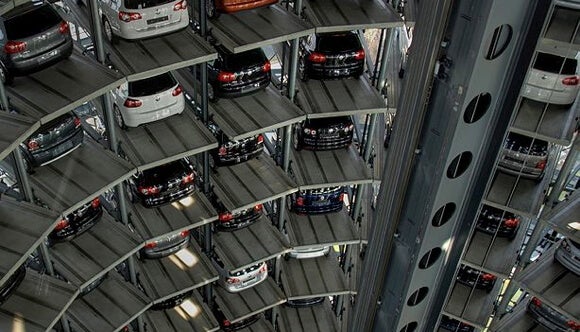More Common Overseas, Automated Parking Garages Are Popping Up in the US

Share
There’s a new perk in high-end apartment buildings—fully robotic parking lots. No more careless valet dinging the Rolls at 1706 Rittenhouse, Philadelphia. Tenants pull their car onto a lift and the system takes it from there. When a tenant wants to leave, they swipe a special fob, and the system locates and retrieves their car.
For those who haven’t encountered one, it may surprise that automated parking lots aren’t new at all. Although they’ve taken longer to catch on in the US, Asia and Europe have been using them for years. According to Shannon Sanders of Southern Illinois University, Japan has 1.6 million automated parking spots. And check out this robotic parking tower in Germany:
Here in the US, there are automated or semi-automated garages across the country, including in New York, Philadelphia, Miami, and Los Angeles. In 2016, the Porsche Design Tower in Miami will offer a lift and parking spot right next to your apartment for a mere $500,000 (on top of the $22+ million you’ve already shelled out.)
Be Part of the Future
Sign up to receive top stories about groundbreaking technologies and visionary thinkers from SingularityHub.


Wider use of automated parking garages could make for more efficient future cities. Even with bike lanes and public transportation, parking is a perennial problem in dense urban environments, where space is a precious commodity.
In automated garages, each car can be parked much closer to its neighbors as there are no doors opening and shutting or space needed for manual parking maneuvers. Nobody accesses the car while it’s parked, so the space above can be reduced. And of course, there's no need to build ramps, lanes, stairs, or elevators for folks to enter and leave.
Depending on whether automated garages are above or below ground, building costs can be competitive with traditional garages, and they can bring in more income per cubic foot (twice the parking capacity for the same volume). Automated garages reduce some operating costs, like labor, ventilation, and lighting, but they add others, like expensive maintenance and hefty electric bills.
Less tangible benefits include saved time looking for a spot, fewer break-ins, and enhanced safety and convenience for drivers, who no longer have to wander sparsely populated lots trying to remember where they parked.
For urban planners, however, perhaps the best argument in favor of automation is that unlike traditional garages, which tend to sprawl, automated auto towers can be built narrow and tall, reducing their footprint. Perhaps as parking spaces extend skyward, future cities will become more livable on the ground.
Image Credit: DooMMeeR/Wikimedia Commons
Jason is editorial director at SingularityHub. He researched and wrote about finance and economics before moving on to science and technology. He's curious about pretty much everything, but especially loves learning about and sharing big ideas and advances in artificial intelligence, computing, robotics, biotech, neuroscience, and space.
Related Articles

This Week’s Awesome Tech Stories From Around the Web (Through December 13)

New Immune Treatment May Suppress HIV—No Daily Pills Required

How Scientists Are Growing Computers From Human Brain Cells—and Why They Want to Keep Doing It
What we’re reading

